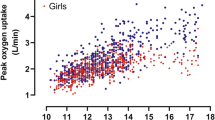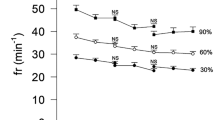Abstract
Purpose
The presence of a maturational threshold that modulates children’s physiological responses to exercise training continues to be debated, not least due to a lack of longitudinal evidence to address this question. The purpose of this study was to investigate the interaction between swim-training status and maturity in nineteen trained (T, 10 ± 1 years, −2.4 ± 1.9 years pre-peak height velocity, 8 boys) and fifteen untrained (UT, 10 ± 1 years, −2.3 ± 0.9 years pre-peak height velocity, 5 boys) children, at three annual measurements.
Methods
In addition to pulmonary gas exchange measurements, stroke volume (SV) and cardiac output (\(\dot{Q}\)) were estimated by thoracic bioelectrical impedance during incremental ramp exercise.
Results
At baseline and both subsequent measurement points, trained children had significantly (P < 0.05) higher peak oxygen uptake (year 1 T 1.75 ± 0.34 vs. UT 1.49 ± 0.22; year 2 T 2.01 ± 0.31 vs. UT 1.65 ± 0.08; year 3 T 2.07 ± 0.30 vs. UT 1.77 ± 0.16 l min−1) and \(\dot{Q}\) (year 1 T 15.0 ± 2.9 vs. UT 13.2 ± 2.2; year 2 T 16.1 ± 2.8 vs. UT 13.8 ± 2.9; year 3 T 19.3 ± 4.4 vs. UT 16.0 ± 2.7 l min−1). Furthermore, the SV response pattern differed significantly with training status, demonstrating the conventional plateau in UT but a progressive increase in T. Multilevel modelling revealed that none of the measured pulmonary or cardiovascular parameters interacted with maturational status, and the magnitude of the difference between T and UT was similar, irrespective of maturational status.
Conclusion
The results of this novel longitudinal study challenge the notion that differences in training status in young people are only evident once a maturational threshold has been exceeded.

Similar content being viewed by others
References
Al Alwan I, Felimban N, Altwaijri Y, Tamim H, Al Mutair A, Shoukri M, Tamimi W (2010) Puberty onset among boys in Riyadh, Saudi Arabia. Clin Med Insights Pediatr 4:19–24
Armstrong N, Welsman JR (1994) Assessment and interpretation of aerobic fitness in children and adolescents. Exerc Sport Sci Rev 22:435–476
Baquet G, Van Praagh E, Berthoin S (2003) Endurance training and aerobic fitness in young people. Sports Med 33:1127–1143
Barker AR, Williams CA, Jones AM, Armstrong N (2009) Establishing maximal oxygen uptake in young people during a ramp cycle test to exhaustion. Br J Sports Med
Baxter-Jones A, Goldstein H, Helms P (1993) The development of aerobic power in young athletes. J Appl Physiol 75:1160–1167
Beaver WL, Wasserman K, Whipp BJ (1986) A new method for detecting anaerobic threshold by gas-exchange. J Appl Physiol 60:2020–2027
Bianchi G, Nardi P, Cecchetti F, Parisi A, Pelliccia A (1998) Study of “athlete’s heart” in young footballers: influence of athletic activity and pubertal growth. Med Sport 51:171–177
Danis A, Kyriazis Y, Klissouras V (2003) The effect of training in male prepubertal and pubertal monozygotic twins. Eur J Appl Physiol 89:309–318
Eriksson BO, Gollnick PD, Saltin B (1973) Muscle metabolism and enzyme activities after training in boys 11–13 years old. Acta Physiol Scand 87:485–497
Haycock GB, Schwartz GJ, Wisotsky DH (1978) Geometric method of measuring body surface area. J Pediatr 93:62–66
Katch VL (1983) Physical conditioning of children. J Adolesc Health 3:241–246
Kobayashi K, Kitamura K, Miura M, Sodeyama H, Miyashita M, Matsui H (1978) Aerobic power as related to body growth in Japanese boys: a longitudinal study. J Appl Physiol 44:666–672
McManus AM, Armstrong N, Williams CA (1997) Effect of training on the aerobic power and anaerobic performance of prepubertal girls. Acta Paediatr 86:456–459
McNarry MA, Welsman JR, Jones AM (2010) Influence of training and maturity status on the cardiopulmonary responses to ramp incremental cycle and upper body exercise in girls. J Appl Physiol 110:375–381
McNarry MA, Welsman JR, Jones AM (2011) The influence of training and maturity status on girls’ responses to short-term, high-intensity upper and lower body exercise. Appl Physiol Nutr Metab 36:344–352
Mirwald RL, Bailey DA, Cameron N, Rasmussen RL (1981) Longitudinal comparison of aerobic power in active and inactive boys aged 7.0 to 17.0 years. Ann Hum Biol 8:405–414
Mirwald RL, Baxter-Jones ADG, Bailey DA, Beunen GP (2002) An assessment of maturity from anthropometric measurements. Med Sci Sports Exerc 34:689–694
Nottin S, Vinet A, Stecken F, N’Guyen LD, Ounissi F, Lecoq AM, Obert P (2002) Central and peripheral cardiovascular adaptations to exercise in endurance-trained children. Acta Physiol Scand 175:85–92
Obert P, Courteix D, Lecoq AM, Guenon P (1996) Effect of long-term intense swimming training on the upper body peak oxygen uptake of prepubertal girls. Eur J Appl Physiol Occup Physiol 73:136–143
Obert P, Mandigouts S, Nottin S, Vinet A, N’Guyen LD, Lecoq AM (2003) Cardiovascular responses to endurance training in children: effect of gender. Eur J Clin Investig 33:199–208
Ostojic SM, Stojanovic M, Jukic I, Pasalic E, Jourkesh M (2009) The effects of six weeks of training on physical fitness and performance in teenage and mature top-level soccer players. Biol Sport 26:379–387
Pantsiotou K (2007) Data on pubertal development in Greek boys. A longitudinal study. Hormones 6:148–151
Regaieg S, Charfi N, Kamoun M, Ghroubi S, Rebai H, Elleuch H, Feki M, Abid M (2013) The effects of an exercise training program on body composition and aerobic capacity parameters in Tunisian obese children. Indian J Endocrinol Metab 17:1040–1045
Rowland TW (1997) The “trigger hypothesis” for aerobic trainability: a 14-year follow-up. Pediatr Exerc Sci 9:1–9
Rowland TW (2009) Endurance athletes’ stroke volume response to progressive exercise: a critical review. Sports Med 39:687–695
Rowland TW, Goff D, Popowski B, DeLuca P, Ferrone L (1998) Cardiac responses to exercise in child distance runners. Int J Sports Med 19:385–390
Rowland TW, Unnithan V, Fernhall B, Baynard T, Lange C (2002) Left ventricular response to dynamic exercise in young cyclists. Med Sci Sports Exerc 34:637–642
Rowland TW, Bougault V, Walther G, Nottin S, Vinett A, Obert P (2009a) Cardiac responses to swim bench exercise in age-group swimmers and non-athletic children. J Sci Med Sport 12:266–272
Rowland TW, Garrard M, Marwood S, Guerra E, Roche D, Unnithan VB (2009b) Myocardial performance during progressive exercise in athletic adolescent males. Med Sci Sports Exerc 41:1721–1728
Slaughter MH, Lohman TG, Boileau RA, Horswill CA, Stillman RJ, Vanloan MD, Bemben DA (1988) Skinfold equations for estimation of body fatness in children and youth. Hum Biol 60:709–723
Twisk JWR (2006) Basic principles of mutlilevel analysis. In: Applied multilevel analysis. Cambridge University Press, Cambridge, pp 6–29
Unnithan V, Rowland TW, Cable NT, Raine N (1997) Cardiac responses to exercise in elite male junior cyclists. In: Armstrong N, Kirby BJ, Welsman J (eds) Children and Exercise XIX. E & FN Spon, London, pp 501–506
Weber G, Kartodihardjo W, Klissouras V (1976) Growth and physical-training with reference to heredity. J Appl Physiol 40:211–215
Welsman J, Armstrong N (2000) Statistical techniques for interpreting body size-related exercise performance during growth. Pediatr Exerc Sci 12:112–127
Welsman J, Bywater K, Farr C, Welford D, Armstrong N (2005) Reliability of peak VO2 and maximal cardiac output assessed using thoracic bioimpedance in children. Eur J Appl Physiol 94:228–234
Conflict of interest
There are no conflicts of interest or funding to disclose.
Author information
Authors and Affiliations
Corresponding author
Additional information
Communicated by Massimo Pagani.
Rights and permissions
About this article
Cite this article
McNarry, M.A., Mackintosh, K.A. & Stoedefalke, K. Longitudinal investigation of training status and cardiopulmonary responses in pre- and early-pubertal children. Eur J Appl Physiol 114, 1573–1580 (2014). https://doi.org/10.1007/s00421-014-2890-1
Received:
Accepted:
Published:
Issue Date:
DOI: https://doi.org/10.1007/s00421-014-2890-1




